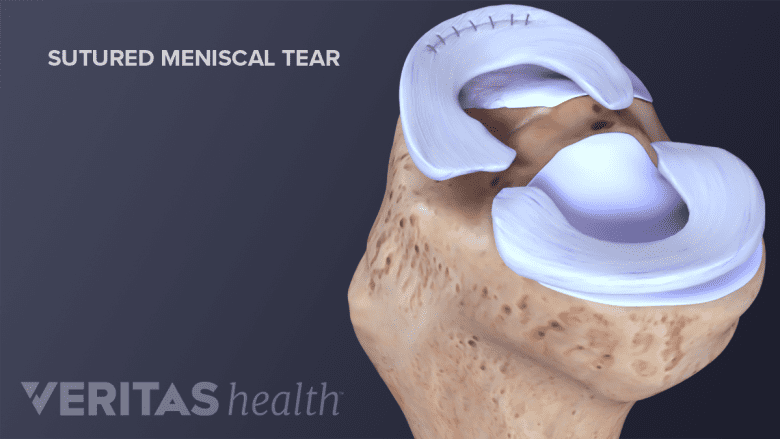A torn knee meniscus can sometimes be repaired with surgery. A doctor’s recommendation to have meniscal repair surgery will be based on many factors, including:
- The patient’s symptoms, including knee pain, decreased range of motion, and instability
- Whether other structures, such as knee ligaments, are loose or damaged
- The patient’s age, overall health, and lifestyle goals, such as returning to a sport(s)
- The meniscal tear’s underlying cause, location, shape, and size
See Understanding Meniscus Tears
If the doctor thinks surgery is appropriate, he or she will advise the patient and discuss what the patient can reasonably expect after surgery.
See 4 Factors Affecting Knee Meniscus Surgery
Like most knee surgeries, meniscal repair surgery is elective—meaning the patient can decide whether or not to have it.
In This Article:
- Knee Surgery for a Torn Meniscus
- Recovering From Meniscus Repair Surgery
Repairing Knee Laxity
Many people who have a torn meniscus also have knee laxity, a condition in which the knee’s ligaments are too loose. During surgery to repair a meniscal tear, a surgeon can also perform a procedure to tighten ligaments so the knee joint is better supported.
See Symptoms of Meniscal Tears
This procedure, called ligament stabilization, reduces the risk of future meniscal tears. It also extends post-surgical healing time.
Meniscus Repair Surgery, Step-by-Step

Meniscal repair involves locating the tear and suturing the torn tissue.
This surgery is an outpatient procedure and almost always done arthroscopically. Arthroscopic surgery requires only small incisions, so tissue damage is minimized and recovery time is faster.
During surgery, the doctor will:
- Make several small incisions (about 1 cm each) around the knee.
- Insert instruments through the incisions. One of these instruments will be an arthroscope, which has a camera to visualize the inside of the knee.
- Probe the inside of the knee and identify the area(s) of damaged meniscus. The surgeon will use this opportunity to check for other knee problems that might not be apparent from previous medical imaging, such as an MRI.
- Use special tools to smooth some of the edges of the damaged meniscus. The surgeon may also smooth nearby articular cartilage and remove any damaged pieces. The medical term for trimming and reshaping any type of cartilage—either the meniscus or articular cartilage—is chondroplasty.
- Stitch together the torn pieces of meniscal tissue. In most cases, sutures will be placed about 3 mm apart. For example, a 1.5 cm tear would require about 5 stitches.
- Perform ligament stabilization, if planned.
- Suction out any pieces of free-floating cartilage or other tissues from the knee capsule.
- Remove the surgical instruments from the knee and close the small incisions.
Often times a meniscal tear cannot be surgically repaired. In these cases, the surgeon may remove the damaged part of the meniscus, a procedure called partial menisectomy.
After surgery, the patient will be wheeled into a recovery room. Once the general anesthesia wears off, the patient will be sent home.
Most patients are given a brace to protect the knee and are prescribed physical therapy.
Potential risks and complications
Complications occur in less than 2% of patients. Infections occur in less than 1% of patients.1Phillips BB and Mihalko MJ. Arthroscopy of the Lower Extremity. In: Canale ST, Beaty JH, eds. Campell’s Operative Orthopaedics, 12th ed. Philadelphia, PA: Mosby, Inc; 2013:2393-2465
- 1 Phillips BB and Mihalko MJ. Arthroscopy of the Lower Extremity. In: Canale ST, Beaty JH, eds. Campell’s Operative Orthopaedics, 12th ed. Philadelphia, PA: Mosby, Inc; 2013:2393-2465

